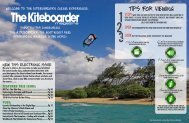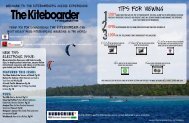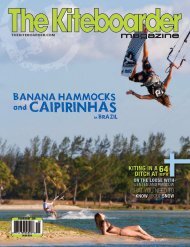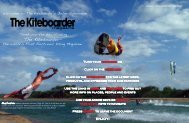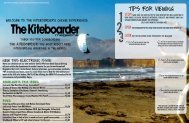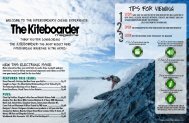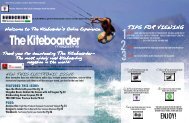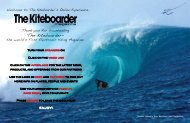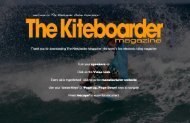Pimp Yo Kite - The Kiteboarder Magazine
Pimp Yo Kite - The Kiteboarder Magazine
Pimp Yo Kite - The Kiteboarder Magazine
You also want an ePaper? Increase the reach of your titles
YUMPU automatically turns print PDFs into web optimized ePapers that Google loves.
Guillaume Chastagnol: <strong>The</strong> three-time World Snowkite Champion continues to<br />
awe us with his combination of freestyle moves and hang time.<br />
Snowkiting has been making its way around the globe for decades, and<br />
since the turn of the 21st century it has been reshaping the way we look<br />
at winter across North America.<br />
With a rebirth of new equipment and grass roots events, the sport<br />
saw new interest in 2001, starting a momentum that would lead to a fiveyear<br />
growth trend across the country. Now, snowkiters can be found on<br />
frozen lakes and snow covered hillsides from New Hampshire to California<br />
and every windy spot in between. <strong>The</strong> event and competition scene<br />
has evolved tremendously, with some of the original events passing on<br />
and others growing to attract international fame, bringing acclaimed riders<br />
from all over Europe to American slopes. Looking ahead, the 06/07<br />
winter season is shaping up with more snowkiting opportunities coming<br />
available on a nationwide demo tour, and even bigger comps like the US<br />
Open Snowkite Masters, that will offer cash prizes with an all-star cast.<br />
12<br />
EVOLUTION<br />
From the backyard to the backcountry, during its<br />
evolution, many users have adapted the power<br />
of snowkites to enhance their riding situation.<br />
Skiers in the Midwest claim riding under kite<br />
power across flat frozen lakes in the late 1970’s,<br />
while mountaineers of the same era used kites<br />
to power trans-arctic expeditions, where skiers<br />
used kites to pull themselves and hundred pound<br />
gear-sleds across endless miles of arctic terrain.<br />
Today, there are hundreds of snowkiters across<br />
the country taking advantage of wind power to ski<br />
faster and farther than local slopes can allow, and<br />
utilizing the miles of frozen lakes and farm fields<br />
that dot the landscape. After a good snowstorm,<br />
the area from North Dakota to Pennsylvania<br />
becomes the biggest ski area in the country with<br />
a snowkite, and more people are jumping on the<br />
opportunity to ride new local terrain every season.<br />
<strong>The</strong> Rocky Mountains are also seeing skiers and<br />
snowboarders hooking into kites to experience<br />
uphill riding and the third dimension of<br />
freestyle that kiting allows. While only a few<br />
resorts offer access to kite friendly terrain,<br />
every snowkiter has been a pioneer exploring<br />
and exploiting what are becoming the<br />
new Mecca’s of kiting.<br />
COMPETITION TREND<br />
<strong>The</strong> worldwide trend in competitions has<br />
leaned towards freestyle for years, until<br />
the 05/06 winter saw a drastic change with<br />
a shifting emphasis towards races, both<br />
kitercross and traditional sailing circuits.<br />
While a debatable topic, many snowkiters<br />
believe that the kitercross race format actually<br />
started at the original Snowkite Rodeo<br />
in Montana. <strong>The</strong> multi-rider course pits several<br />
personalities against ramps, obstacles<br />
and turn points in an all or nothing battle to<br />
the finish line. Unlike freestyle where technical<br />
ability is judged and critiqued, the race<br />
style competitions allow the less flexible yet<br />
more strategic minds to have an upper hand<br />
in the round. In the flat lands, Minnesota<br />
boasts its distance challenge with a race<br />
against the clock across the 20-mile wide<br />
lake, Mille Lacs. ‘Winduro’ courses like this<br />
are also gaining popularity, as all riders hit<br />
the course at once, instead of splitting into<br />
heats which is necessary in the kitercross<br />
style course. With everyone on the run at<br />
once, it is amazing to see the crowds separate,<br />
with the skiers grouping into a pack in<br />
the lead, and snowboarders choosing their<br />
own random upwind and downwind options.<br />
THE 06/07 SEASON<br />
This winter is the biggest ever in North<br />
American snowkiting, with more locations<br />
to ride, and more events, races and<br />
kite demonstrations to attend. Areas like<br />
Skyline are becoming destinations for kiters<br />
By Brian Schenck<br />
Photos by Warick Arnaude<br />
With road gaps like this mammoth effort, Chasta<br />
doesn’t look to lose his top spot anytime soon.<br />
from every corner and local schools are<br />
gaining popularity sharing the gift of winter<br />
kiteboarding in their home towns. In addition<br />
to the bigger events that host regional<br />
competitions, there will also be many local<br />
circuits with kitercross and Winduro style<br />
racing. Intermountain snowkiting shops are<br />
getting together to create a low profile circuit<br />
that will allow kiters to get involved with<br />
racing while keeping it fun spirited. After<br />
long standing snowkite celebrations like the<br />
Montana Snowkite Rodeo and Vermont <strong>Kite</strong>storm,<br />
the season finale will round out with<br />
the US Open Snowkite Masters, a showdown<br />
of skills in Utah’s Wasatch Range.<br />
Brian Schenck is the US distributor for Ozone<br />
<strong>Kite</strong>s. For a list of upcoming comps and demos,<br />
see the SMACK section or check out<br />
www.windzup.com for the latest info.<br />
13



